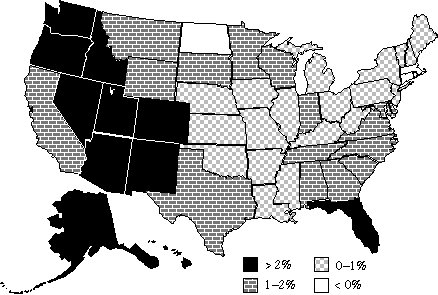Urban areas growing at 2 percent per year will double their populations in just
36 years. At this rate, development takes place so rapidly that people can
almost see it from day to day. Highways get more crowded, open space fills up,
and sleepy towns around the urban fringes quickly become urban centers as new
homes, offices, and shopping malls sprawl across the countryside.
Not counting immigration, the population of the U.S. is barely growing, and
probably won't double for at least 150 years. But this near-zero population
growth disguises major shifts in the populations of U.S. regions. In great
numbers, Americans are fleeing the climatically inhospitable and densely
populated Northeast and Midwest for the sunny South and the thinly populated
West.

Annual population growth rates between 1990 and 1995. Source: Census Bureau.
- The Census Bureau says that the ten fastest-growing states in the nation
since 1990 are all in the West, all of them growing faster than 2 percent per
year. All but one of the top twenty are in the West or South.
- The nation's 40 fastest-growing urban areas, 33 of which are growing
faster than 2 percent per year, are all in the West or South.
Rapid growth
means that many southern and western communities are experiencing serious
"growing pains." In a few states, including Alaska, Montana, and Wyoming, the
rural areas in these states are growing faster than cities. This suggests that
growth is actually two different types of problems:
- The rapid growth of urban areas, especially southern and western cities of
about a quarter million people or more, which are magnets for service and
high-tech industries looking for a high quality of life for their employees.
- The growth of rural areas, where retirees, trust fund babies, and
telecommuters are attracted by scenery, open space, and low population
densities.
Both kinds of growth lead to strife between existing residents
and newcomers. This is especially true in the West, where spectacular scenery
and a clean environment have always been associated, in local residents' minds,
with small numbers of people. People who find themselves rubbing shoulders with
others in supposedly wide-open spaces soon demand government regulation of
growth.
Although the stresses are the same, the problems and solutions differ. No one
thinks that Livingston, Montana or Las Cruces, New Mexico need a light-rail
system. Nor is anyone proposing to turn Denver or Seattle into a buffalo
commons.
This issue of Different Drummer focuses on urban growth problems. Our
research paper, Transitions, looked at rural growth; we hope to take up
that issue in more detail soon.
We use Portland as a model both because that is where we live and because so
many other people point to Portland's growth management as a model for other
fast-growing regions. Oregon and Portland share a reputation for pioneering
solutions to both rural and urban growth problems:
- Oregon's land-use planning laws, passed in 1973, remain among the
strongest in the nation.
- Portland claims to have one of the most successful light-rail systems in
the country.
- Metro, a new regional planning agency with unprecedented powers, manages
growth through a combination of urban-growth boundaries, zoning, and other
prescriptive tools.
Civic leaders in fast-growing cities throughout the
nation eye these programs with envy. Dallas, Denver, Austin, and Seattle are
building or contemplating rail transit lines. Along with rail will come some of
the growth-management techniques used in Portland, for planners agree that rail
transit's success requires a complete redesign of our cities. Regional planning
agencies in more than 300 U.S. cities wish they had the authority that Portland
has granted to Metro.
Urban-growth boundaries, light rail, and regional planning agencies are
textbook solutions to growth. But a hard look at Portland's programs suggests
that the textbook is wrong. If you live in a fast-growing urban area, this
issue of Different Drummer could open your eyes to problems you didn't
even know existed.
Electronic Drummer | Different Drummer | The Vanishing Automobile | Reports

